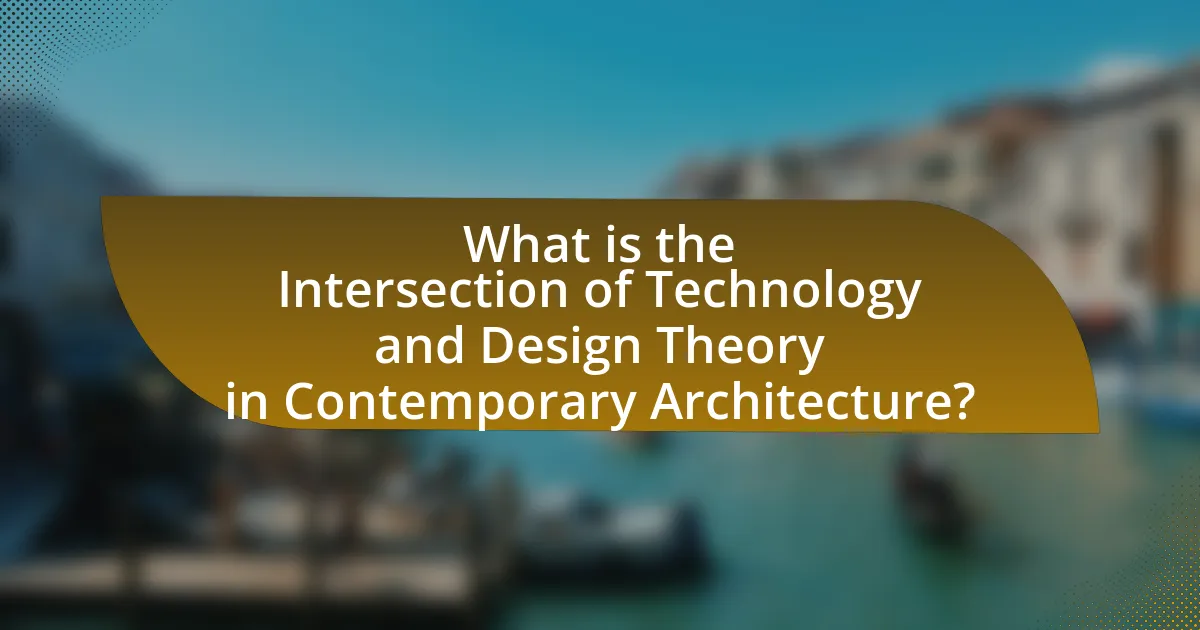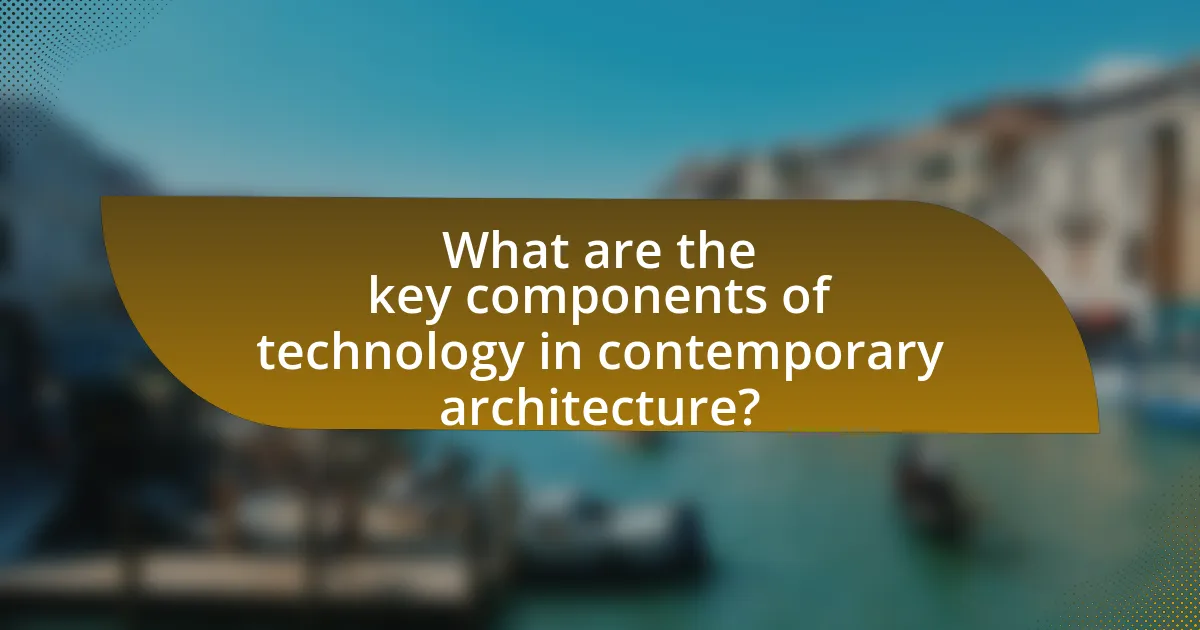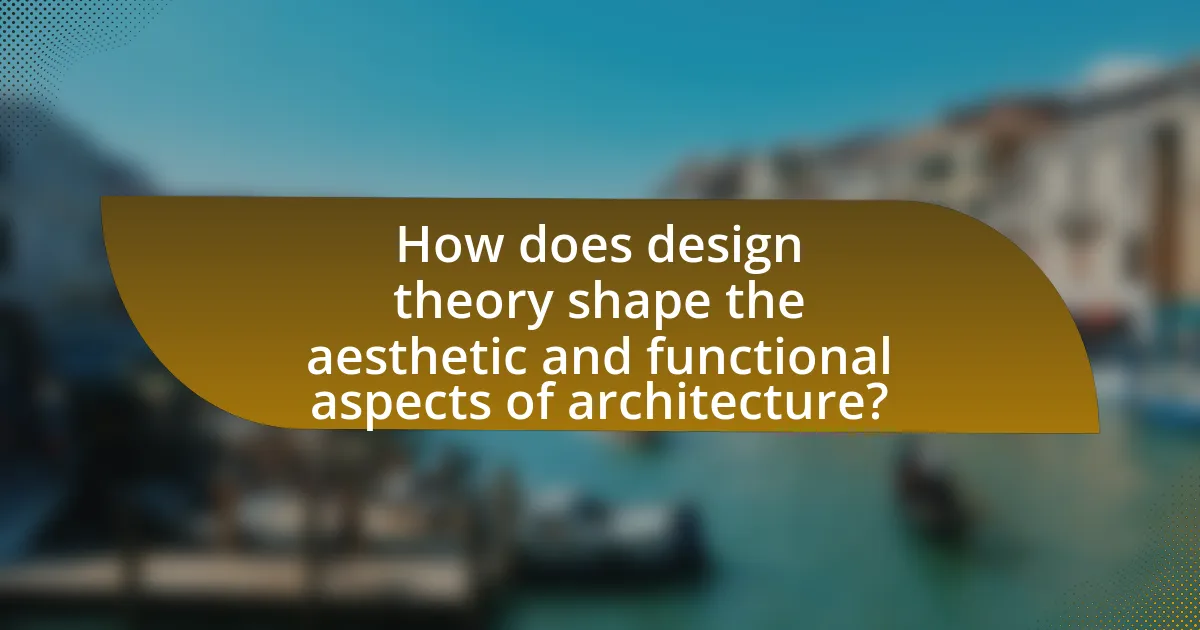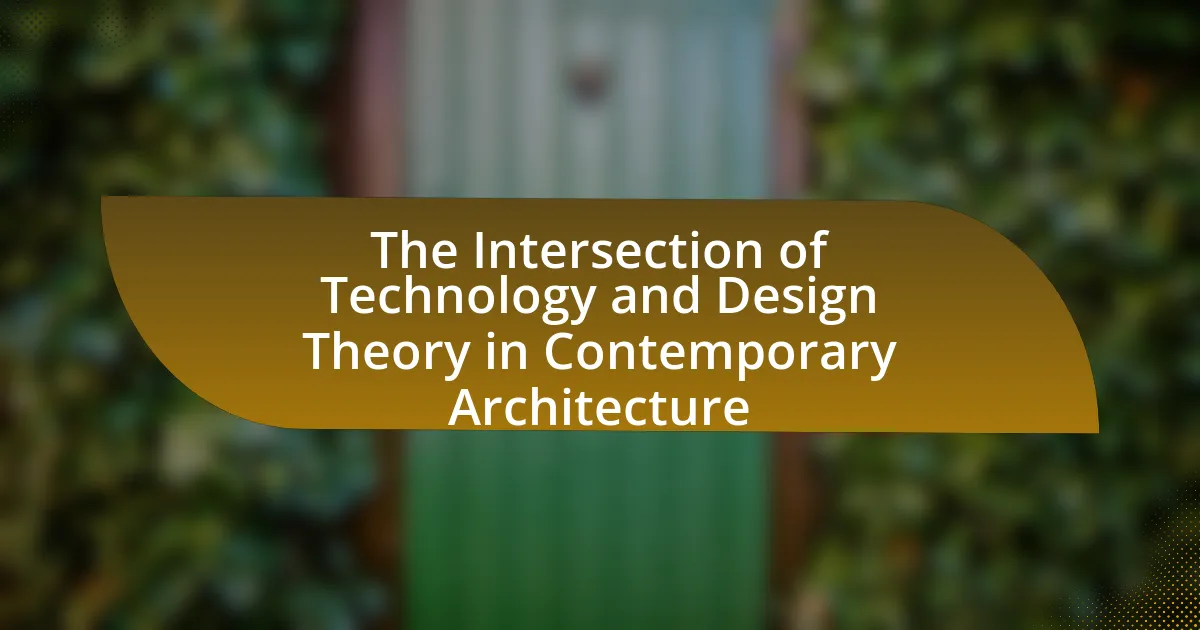The article explores the intersection of technology and design theory in contemporary architecture, highlighting how advanced digital tools and methodologies enhance the design process and building performance. Key topics include the role of Building Information Modeling (BIM), sustainable materials, and smart building technologies in facilitating innovative and efficient architectural solutions. The integration of design theories, such as sustainability and user experience, is examined, along with the challenges architects face in merging technology with traditional design principles. Additionally, the article discusses emerging trends and best practices for achieving cohesive design visions in technologically advanced projects.

What is the Intersection of Technology and Design Theory in Contemporary Architecture?
The intersection of technology and design theory in contemporary architecture is characterized by the integration of advanced digital tools and methodologies that enhance the design process and building performance. This integration allows architects to utilize parametric design, Building Information Modeling (BIM), and computational design, which facilitate innovative forms and efficient structures. For instance, the use of BIM enables real-time collaboration among stakeholders, improving accuracy in project delivery and reducing costs. Additionally, technologies such as 3D printing and virtual reality are reshaping how architects conceptualize and visualize spaces, leading to more sustainable and user-centered designs. This synergy between technology and design theory not only optimizes functionality but also fosters creativity, as seen in projects like the Eden Project in the UK, which employs cutting-edge materials and design principles to create an environmentally responsive architecture.
How do technology and design theory influence contemporary architectural practices?
Technology and design theory significantly influence contemporary architectural practices by enabling innovative design solutions and enhancing functionality. Advanced software tools, such as Building Information Modeling (BIM), allow architects to create precise digital representations of structures, facilitating better collaboration and efficiency throughout the design and construction processes. Additionally, design theories, such as sustainable architecture, inform the integration of eco-friendly materials and energy-efficient systems, which are increasingly prioritized in modern projects. For instance, the use of renewable energy technologies, like solar panels and green roofs, reflects a commitment to sustainability that is rooted in contemporary design theory. This synergy between technology and design theory not only improves aesthetic outcomes but also addresses pressing environmental concerns, demonstrating their critical role in shaping the future of architecture.
What are the key technological advancements shaping modern architecture?
Key technological advancements shaping modern architecture include Building Information Modeling (BIM), sustainable materials, and smart building technologies. BIM allows architects to create detailed digital representations of buildings, improving collaboration and efficiency throughout the design and construction process. Sustainable materials, such as recycled and low-carbon options, are increasingly used to minimize environmental impact, with studies showing that using these materials can reduce a building’s carbon footprint by up to 30%. Smart building technologies, which incorporate IoT devices and automation systems, enhance energy efficiency and occupant comfort, with research indicating that smart buildings can achieve energy savings of 20-30% compared to traditional structures.
How does design theory inform the integration of technology in architecture?
Design theory informs the integration of technology in architecture by providing a framework that guides the application of technological tools to enhance aesthetic and functional outcomes. This framework emphasizes principles such as form, space, and user experience, which help architects make informed decisions about how technology can be utilized effectively. For instance, the use of parametric design software allows architects to explore complex geometries and optimize building performance, aligning with design theories that prioritize innovation and sustainability. Research by KieranTimberlake in their publication “Refabricating Architecture” illustrates how technology can be seamlessly integrated into architectural design, demonstrating that a theoretical foundation can lead to more efficient and creative architectural solutions.
Why is the intersection of technology and design theory important in architecture?
The intersection of technology and design theory is crucial in architecture because it enhances the functionality, sustainability, and aesthetic appeal of built environments. This integration allows architects to leverage advanced tools and materials, such as Building Information Modeling (BIM) and sustainable materials, to create innovative designs that respond to environmental challenges. For instance, the use of parametric design software enables architects to optimize structures for energy efficiency, resulting in buildings that consume less energy and reduce carbon footprints. Furthermore, research from the American Institute of Architects indicates that incorporating technology in design processes leads to improved collaboration and communication among stakeholders, ultimately resulting in more successful project outcomes.
What challenges do architects face when merging technology with design theory?
Architects face several challenges when merging technology with design theory, primarily including the integration of complex software tools, the need for continuous skill development, and the balancing of aesthetic values with functional requirements. The rapid evolution of technology necessitates that architects stay updated with new tools and methodologies, which can be time-consuming and costly. Additionally, architects must navigate the tension between innovative design and practical constraints, such as budget limitations and regulatory compliance. For instance, a study by the American Institute of Architects highlights that 70% of architects report difficulties in adapting to new technologies while maintaining design integrity. This underscores the ongoing struggle to harmonize technological advancements with traditional design principles.
How can this intersection enhance sustainability in architecture?
The intersection of technology and design theory can enhance sustainability in architecture by enabling the integration of advanced materials and energy-efficient systems into building designs. For instance, the use of Building Information Modeling (BIM) allows architects to optimize resource use and minimize waste during the construction process, leading to a reduction in the carbon footprint of buildings. Additionally, technologies such as solar panels and green roofs can be seamlessly incorporated into design theories that prioritize environmental harmony, resulting in structures that not only consume less energy but also contribute positively to their surroundings. Studies have shown that buildings designed with these technologies can achieve energy savings of up to 30% compared to traditional designs, demonstrating the effectiveness of this intersection in promoting sustainable architecture.

What are the key components of technology in contemporary architecture?
The key components of technology in contemporary architecture include Building Information Modeling (BIM), sustainable materials, smart building systems, and advanced construction techniques. Building Information Modeling enhances collaboration and efficiency by allowing architects and engineers to create digital representations of physical structures, facilitating better planning and management. Sustainable materials, such as recycled and low-impact resources, contribute to environmental responsibility and energy efficiency in building design. Smart building systems integrate IoT technology to optimize energy use, enhance security, and improve occupant comfort through automated controls. Advanced construction techniques, including prefabrication and 3D printing, streamline the building process, reduce waste, and enable innovative design solutions. These components collectively reflect the integration of technology in enhancing functionality, sustainability, and aesthetics in contemporary architecture.
How do digital tools impact architectural design processes?
Digital tools significantly enhance architectural design processes by improving efficiency, accuracy, and collaboration. These tools, such as Building Information Modeling (BIM) and computer-aided design (CAD) software, allow architects to create detailed 3D models, facilitating better visualization and analysis of designs. For instance, a study by the National Institute of Building Sciences found that BIM can reduce project costs by up to 20% and improve project delivery times by 30%. Additionally, digital tools enable real-time collaboration among stakeholders, streamlining communication and decision-making throughout the design process. This integration of technology not only optimizes workflows but also fosters innovation in architectural solutions.
What role does Building Information Modeling (BIM) play in modern architecture?
Building Information Modeling (BIM) serves as a crucial tool in modern architecture by facilitating enhanced collaboration, visualization, and efficiency throughout the design and construction processes. BIM allows architects and stakeholders to create detailed 3D models that integrate various aspects of a building, including structural, mechanical, and electrical systems, enabling real-time updates and modifications. This integration leads to improved accuracy in project planning and execution, reducing errors and rework, which can account for up to 30% of construction costs according to industry studies. Furthermore, BIM supports sustainable design practices by allowing architects to analyze energy performance and material usage, contributing to environmentally responsible building solutions.
How do virtual and augmented reality technologies influence design visualization?
Virtual and augmented reality technologies significantly enhance design visualization by allowing designers and clients to experience spatial environments in immersive ways. These technologies enable real-time interaction with 3D models, facilitating a deeper understanding of design elements and spatial relationships. For instance, a study by Kensek and Noble in “Building Information Modeling: BIM in Current and Future Practice” highlights that VR and AR can reduce design errors by up to 30% through improved visualization and communication. This immersive experience not only aids in decision-making but also fosters collaboration among stakeholders, ultimately leading to more informed design choices.
What are the implications of smart building technologies in architecture?
Smart building technologies significantly enhance architectural design by improving energy efficiency, occupant comfort, and operational performance. These technologies, such as IoT sensors, automated systems, and data analytics, enable real-time monitoring and management of building resources, leading to reduced energy consumption by up to 30% according to the U.S. Department of Energy. Additionally, smart buildings can adapt to user preferences, enhancing comfort through personalized environmental controls. The integration of these technologies also supports sustainable practices, as evidenced by the increasing number of LEED-certified buildings that utilize smart systems to optimize resource use and minimize environmental impact.
How do smart technologies improve energy efficiency in buildings?
Smart technologies improve energy efficiency in buildings by optimizing energy consumption through automation and real-time data analysis. These technologies, such as smart thermostats, lighting controls, and energy management systems, adjust energy usage based on occupancy and environmental conditions. For instance, smart thermostats can learn user preferences and reduce heating or cooling when spaces are unoccupied, leading to energy savings of up to 10-15% according to the U.S. Department of Energy. Additionally, smart lighting systems can automatically adjust brightness based on natural light levels, further reducing energy waste. Overall, the integration of smart technologies enables buildings to operate more efficiently, minimizing energy costs and environmental impact.
What are the challenges of implementing smart technologies in architectural design?
The challenges of implementing smart technologies in architectural design include high costs, integration complexities, and the need for specialized skills. High costs arise from the initial investment in advanced technologies and ongoing maintenance expenses, which can deter architects and clients. Integration complexities stem from the difficulty of incorporating smart systems with existing building infrastructure, often requiring extensive retrofitting. Additionally, the need for specialized skills presents a barrier, as architects and builders may lack the necessary training to effectively design and implement these technologies, leading to potential project delays and inefficiencies.

How does design theory shape the aesthetic and functional aspects of architecture?
Design theory significantly influences both the aesthetic and functional aspects of architecture by providing a framework for understanding how form, space, and materials interact to create meaningful environments. This framework guides architects in making decisions that enhance visual appeal while ensuring usability and efficiency. For instance, the principles of modernism emphasize simplicity and functionality, leading to designs that prioritize open spaces and natural light, which can be seen in iconic structures like the Villa Savoye by Le Corbusier. Additionally, design theories such as biophilic design advocate for integrating natural elements into architecture, promoting well-being and sustainability, as evidenced by studies showing that buildings incorporating natural light and greenery improve occupant health and productivity. Thus, design theory not only shapes the visual identity of buildings but also directly impacts their performance and the experiences of their users.
What are the fundamental principles of design theory in architecture?
The fundamental principles of design theory in architecture include balance, proportion, scale, rhythm, and harmony. Balance refers to the distribution of visual weight in a structure, ensuring stability and equilibrium. Proportion involves the relationship between different elements, creating a sense of unity and coherence. Scale relates to the size of objects in relation to one another and their environment, affecting perception and functionality. Rhythm is the repetition of elements, guiding the viewer’s eye and creating movement within the design. Harmony ensures that all components work together cohesively, contributing to the overall aesthetic and functional goals of the architecture. These principles are essential for creating effective and meaningful architectural designs.
How do concepts like form, space, and function interact in architectural design?
In architectural design, the concepts of form, space, and function interact dynamically to create cohesive and effective structures. Form refers to the physical shape and aesthetic qualities of a building, while space pertains to the arrangement and organization of areas within that structure. Function denotes the intended use of the building and how well it serves its purpose.
These three elements are interdependent; for instance, the form of a building can influence how space is perceived and utilized, while the function can dictate the necessary spatial arrangements and forms. A study by the American Institute of Architects highlights that successful architectural design harmonizes these aspects, ensuring that the building not only looks appealing but also meets the practical needs of its occupants. This interplay is essential in contemporary architecture, where innovative technologies further enhance the relationship between form, space, and function, leading to more sustainable and user-centered designs.
What role does user experience play in design theory for architecture?
User experience is fundamental in design theory for architecture as it directly influences how individuals interact with and perceive built environments. Architects prioritize user experience to create spaces that are not only functional but also emotionally resonant, enhancing overall satisfaction and usability. Research indicates that environments designed with user experience in mind lead to improved well-being and productivity; for instance, a study published in the Journal of Environmental Psychology found that well-designed spaces can significantly reduce stress and increase user engagement. Thus, integrating user experience into architectural design is essential for fostering positive interactions between people and their surroundings.
How can design theory adapt to technological advancements in architecture?
Design theory can adapt to technological advancements in architecture by integrating digital tools and methodologies that enhance design processes and outcomes. For instance, the use of Building Information Modeling (BIM) allows architects to create more accurate and efficient designs, facilitating collaboration and reducing errors during construction. Additionally, parametric design tools enable architects to explore complex geometries and optimize building performance based on real-time data analysis. These advancements demonstrate that design theory is not static; it evolves by incorporating new technologies that improve functionality, sustainability, and aesthetic value in architectural practice.
What are the emerging trends in design theory influenced by technology?
Emerging trends in design theory influenced by technology include parametric design, generative design, and the integration of artificial intelligence. Parametric design allows architects to create complex forms and structures through algorithms, enabling customization and efficiency in design processes. Generative design utilizes computational algorithms to explore a vast array of design possibilities, optimizing for performance and material usage. The integration of artificial intelligence enhances decision-making in design, allowing for predictive analytics and user-centered design approaches. These trends reflect a shift towards data-driven methodologies, fostering innovation and sustainability in contemporary architecture.
How can architects balance innovation with traditional design principles?
Architects can balance innovation with traditional design principles by integrating modern technologies while respecting historical context and cultural significance. This approach allows architects to create designs that are both functional and aesthetically aligned with traditional values. For instance, the use of sustainable materials and energy-efficient systems can enhance traditional architectural forms without compromising their integrity. A study by the American Institute of Architects highlights that projects incorporating both innovative techniques and traditional aesthetics often receive higher community approval, demonstrating that this balance is not only feasible but also beneficial for societal acceptance.
What best practices can architects follow to effectively integrate technology and design theory?
Architects can effectively integrate technology and design theory by adopting a collaborative approach that involves interdisciplinary teams. This practice ensures that technological advancements are aligned with design principles, enhancing both functionality and aesthetics. For instance, utilizing Building Information Modeling (BIM) allows architects to visualize and simulate designs, facilitating better decision-making and reducing errors during construction. Research indicates that projects employing BIM can reduce costs by up to 20% and improve project delivery times by 30%. Additionally, architects should prioritize user-centered design, leveraging technology to gather data on user experiences and preferences, which can inform design choices. This data-driven approach has been shown to increase user satisfaction and engagement in architectural spaces.
How can collaboration between technologists and designers enhance architectural outcomes?
Collaboration between technologists and designers enhances architectural outcomes by integrating innovative technologies with creative design principles, resulting in more efficient, sustainable, and aesthetically pleasing structures. This partnership allows for the application of advanced tools such as Building Information Modeling (BIM) and parametric design, which streamline the design process and improve accuracy in construction. For instance, a study by the American Institute of Architects found that projects utilizing BIM experienced a 20% reduction in project delivery time and a 15% decrease in costs, demonstrating the tangible benefits of this collaboration. Furthermore, the synergy between technologists and designers fosters a multidisciplinary approach that encourages problem-solving and innovation, ultimately leading to buildings that better meet the needs of users and the environment.
What strategies can be employed to ensure a cohesive design vision in technologically advanced projects?
To ensure a cohesive design vision in technologically advanced projects, employing integrated design processes is essential. This strategy involves collaboration among architects, engineers, and technology specialists from the project’s inception, fostering a shared understanding of goals and aesthetics. Research indicates that projects utilizing integrated design approaches, such as the one outlined in the “Integrated Design Process: A Guide for Architects” by the American Institute of Architects, achieve higher levels of coherence and innovation. By aligning diverse expertise early in the project, teams can create a unified vision that harmonizes technological advancements with architectural intent.
